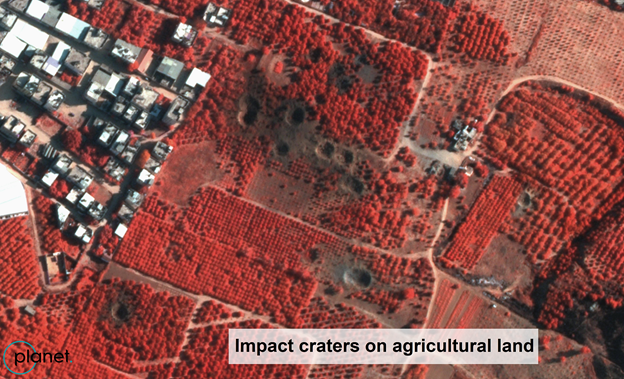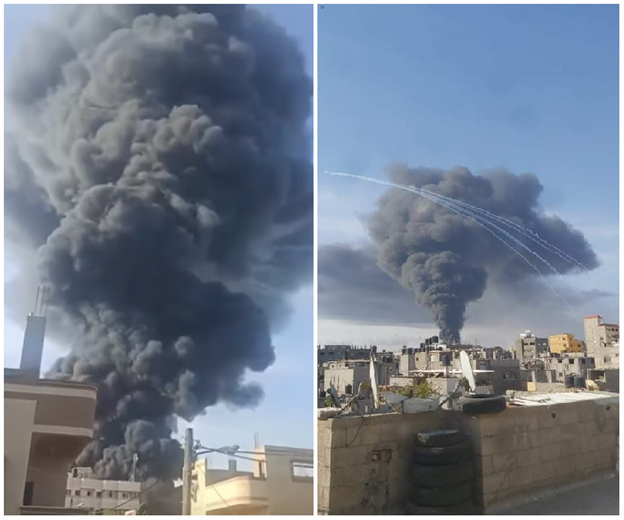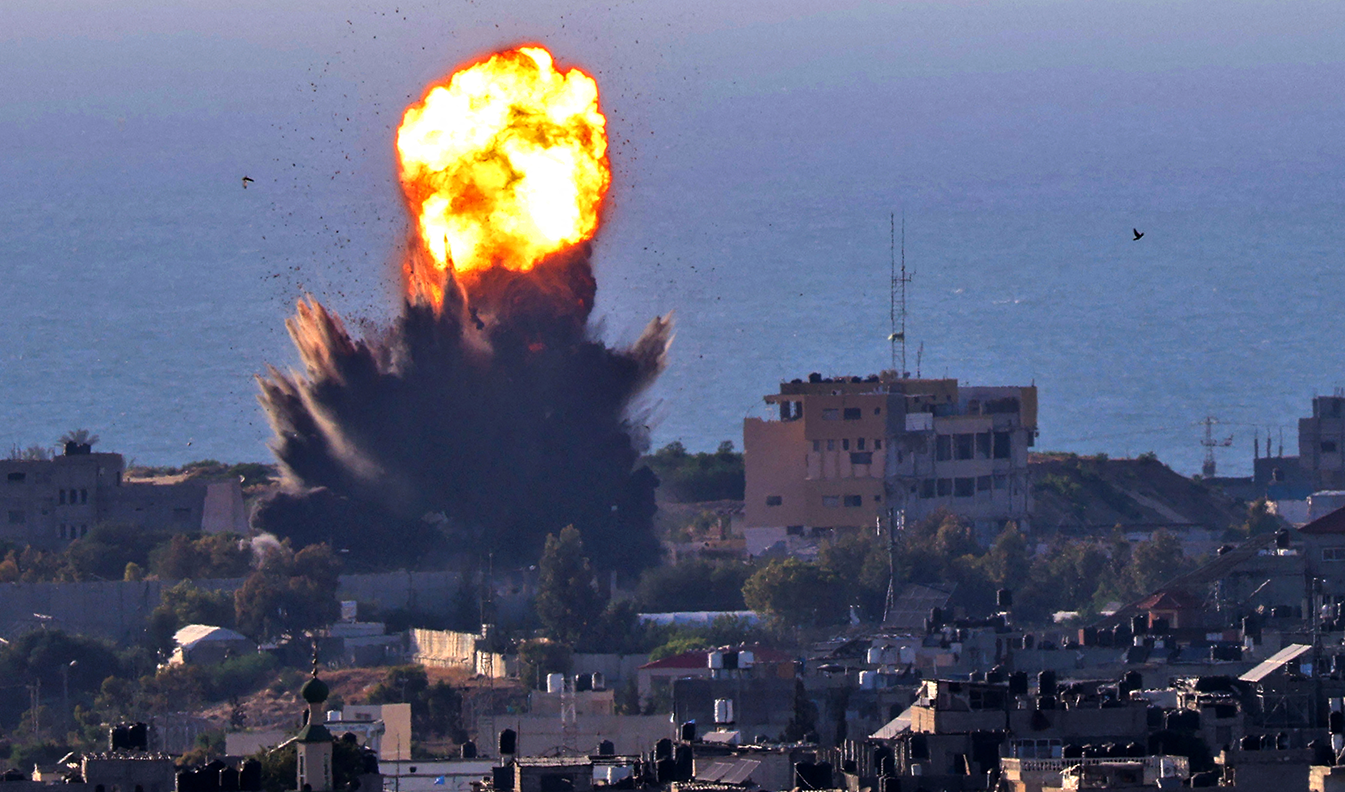The escalation of protest against evictions of Palestinians in Sheikh Jarrah into a full out campaign of rocket fire and airstrikes has as of May 17 resulted in over 200 people killed in Gaza and Israel, over 1,200 wounded and over 40,000 displaced in Gaza alone. Beyond these direct impacts, the indirect and reverberating impacts on civilians’ lives will have longer-term implications from the use of explosive weapons in populated areas, foreboding an increased and extended humanitarian crisis in Gaza.
By Roos Boer and Wim Zwijnenburg
According to the Israeli Defense Forces (IDF), they have launched hundreds of strikes with drones, jet fighters and artillery, while Hamas is claimed to have fired 3,100 rockets and several suicide drones towards Israeli targets.
Prior to the latest escalation, the Gaza strip was already on the brink of collapse, with around 1.85 million people living in an area the size of 362 square km. Decades of economic blockades, military interventions and intense bombing campaigns have rendered the Gaza strip uninhabitable, according to the UN. The use of explosive weapons will exacerbate the humanitarian crisis for people living in the Gaza strip and impact civilians in Israel. The destruction of civilian infrastructure, such as houses, schools and hospitals, and the impacts on the environment will further intensify the long term consequences of the escalation of violence.
Water crisis
A recent UN Environment report published in 2020 paints a bleak picture, with a looming water crisis due to drop of ground water levels and access to safe drinking water falling to less than 11% in 2014, compared with 98.3% in 2000; however, the demand continues to rise. Furthermore, untreated waste and sewage water is being dumped into the sea and overuse of pesticides is raising nitrate concentrations. Open-air solid waste dumps are affecting soil and air quality, while there remain problems in dealing with the large quantities of debris generated by the ongoing conflict. In 2009 alone, there were an estimated 600,000 tons of debris from over 2,600 destroyed buildings. A 2014 UNOSAT satellite analysis showed 6,761 destroyed buildings, 3,565 severely damaged and 4,938 moderately damaged, with a note that often moderately damaged buildings need to be destroyed as they are deemed unsafe; this includes medical facilities and schools. A report and rapid assessment by UNOCHA also noted that 1,855 hectares of agricultural land were identified as razed or heavily damaged, with an additional 1,263 greenhouses destroyed or damaged. Rockets fired by Hamas hit oil storage tankers at Ashkelon, setting off a large fire that burned for days, with significant air pollution from the burning oil, as is visible on satellite imagery via Planet Labs. Hamas also tried to target a gas drilling station in the Mediterranean Sea with suicide drones, but they were intercepted by the IDF before reaching their target.
The 2021 campaign
The ongoing airstrikes have also limited the access to water supplies, as the North Gaza Seawater Desalination Plant has been disrupted, limiting access to water, sanitation and hygiene facilities for 600,000 people. Meanwhile, no fuel is expected to come for the Gaza power plants, further constraining access to electricity. The attacks have also damaged water infrastructure, including pipelines, water wells and pumping stations, with waste water leaking into the streets. Damage to agricultural facilities will also have impacts on food security, according to UNOCHA, with damage to several animal farms, greenhouses and water wells limiting production. An airstrike has also affected Gaza’s largest store of pesticides, which could pose acute chemical risks and potentially pollute the groundwater.

The humanitarian and environmental consequences of the use of explosive weapons will continue to affect the lives and livelihoods of Palestinians. The impacts of the use of explosive weapons in populated areas on civilians is well documented and recognised by over a hundred states. Every year tens of thousands of civilians are killed and injured around the world by bombing and shelling in populated areas. Many more civilians are wounded, and suffer from destruction of homes, hospitals, schools and vital services. Unexploded ordnance exposes civilians to risks during and after hostilities have ended and impedes the safe return of people. As of May 16, it has been reported that in Gaza, six hospitals and three clinics were damaged, while one clinic was completely destroyed. Damage to roads have reportedly further impacted the accessibility of healthcare to victims.
According to the same report by OCHA, as of May 16, some 41 education facilities were affected furthermore, including two kindergartens, schools, an United Nations Relief and Works Agency (UNRWA) vocational training centre, one Ministry of Education directorate building and a higher education facility since the start of the escalation. Reports have indicated that a number of these facilities were directly hit by airstrikes or tank shells.
Health risks
The International Committee of the Red Cross has issued an urgent call for restraint and de-escalation: “Every minute that this cycle of violence continues is a danger to people’s lives, their homes and the services and infrastructure they rely on like hospitals and schools.” The International Network on Explosive Weapons (INEW), of which PAX is a member, has called upon all parties to stop the use of heavy explosive weapons in towns, cities and other populated areas due to the high risk of harm to civilians.
From an environmental perspective, there are acute and long-term risks from conflict-debris and associated health risks from the use of explosive weapons in populated areas, as PAX has previously outlined. For example, pulverized building material is often mixed with heavy metals and other hazardous materials that, if inhaled by first-responders, nearby civilians living in the area or debris clearance crews, could pose a serious health risk. Management of conflict debris will continue to pose environmental challenges for safe storage and reuse.

Damage to water infrastructure is already posing serious public health risks due to the absence of access to clean water, particularly with the COVID-19 pandemic still posing serious challenges for maintenance of hygiene and sanitation. Destroyed sewage systems could further compound health concerns from the spread of COVID-19 and other communicable diseases.
The use of artillery strikes also resulted in large fire at the FoamCo Factory, storing hazardous chemicals, while a smoke screen with obscurants from shelling further raised initial concerns over the use of White Phosphorous, an incendiary weapon. However, in collaboration with weapon experts PAX concludes that this was the use of Elbit M150 155mm shells that uses a mixture of hexachloroethane (HCE), with zinc oxide, that produces white smoke. Though not as acutely hazardous as WP, HC still poses health risks when used in densely populated areas from the smoke’s toxicity when inhaled or when in contact with the skin.

The civilian harm that is caused by the bombing and shelling of towns and cities is unfortunately not new, nor unique to the Gaza conflict. Instead, it is part of a worldwide pattern of harm. According to data gathered by the British organisation Action on Armed Violence, when explosive weapons are used in populated areas 9 out of 10 victims are civilians. And this is only the direct harm. Because the damage explosive weapons cause to critical civilian infrastructure there are many indirect and reverberating effects that need to be taken into account. States around the world will need to challenge the acceptance of the use of heavy explosive weapons in towns and cities.The extensive and repeated use of explosive weapons in populated areas must stop because of the risk it poses to civilians. Until it does, civilians will continue to bear the brunt of the recurring use of explosive weapons in their towns and cities.
Over 100 countries have recognised the harm these weapons cause to civilians when used in populated areas. States are therefore negotiating a political declaration to prevent the harm from the use of explosive weapons in populated areas, under the leadership of Ireland. As a member of INEW, PAX calls upon states to consider the grave civilian and environmental impact of explosive weapons when used in populated areas, and include a commitment to avoid use of explosive weapons with wide area effects in populated areas in the future political declaration.
PAX conducted a rapid remote sensing assessment of the urban damage and potential environmental harm in Gaza, which you can find in this Conflict and Environment Alert.




